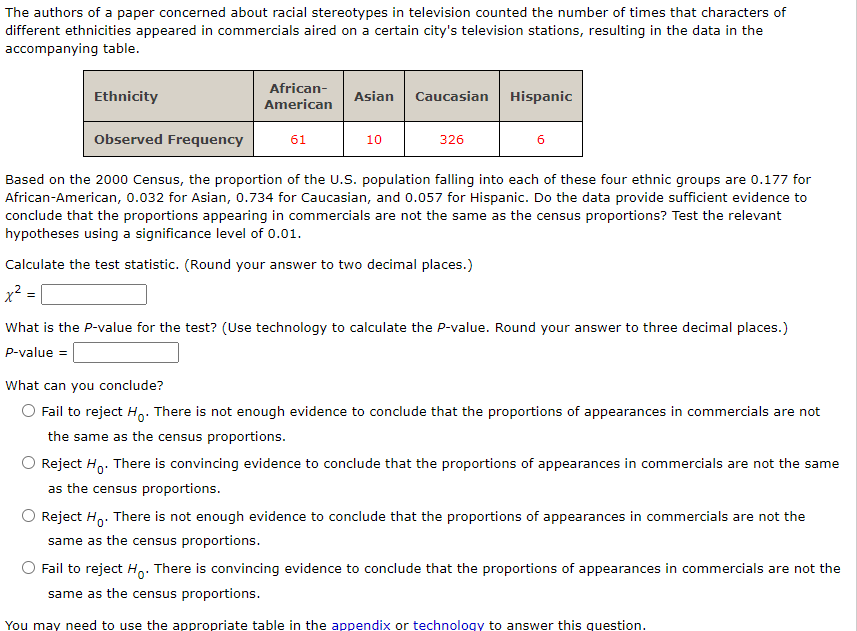The authors of a paper concerned about racial stereotypes in television counted the number of times that characters of different ethnicities appeared in commercials aired on a certain city's television stations, resulting in the data in the accompanying table. African- Ethnicity Asian Caucasian Hispanic American Observed Frequency 61 10 326 6 Based on the 2000 Census, the proportion of the U.S. population falling into each of these four ethnic groups are 0.177 for African-American, 0.032 for Asian, 0.734 for Caucasian, and 0.057 for Hispanic. Do the data provide sufficient evidence to conclude that the proportions appearing in commercials are not the same as the census proportions? Test the relevant hypotheses using a significance level of 0.01. Calculate the test statistic. (Round your answer to two decimal places.) x² = What is the P-value for the test? (Use technology to calculate the P-value. Round your answer to three decimal places.) P-value = What can you conclude? O Fail to reject Ho. There is not enough evidence to conclude that the proportions of appearances in commercials are not the same as the census proportions. Reject H,. There is convincing evidence to conclude that the proportions of appearances in commercials are not the same as the census proportions. Reject H,. There is not enough evidence to conclude that the proportions of appearances in commercials are not the same as the census proportions. Fail to reject H,. There is convincing evidence to conclude that the proportions of appearances in commercials are not the same as the census proportions. You may need to use the appropriate table in the appendix or technology to answer this question.
The authors of a paper concerned about racial stereotypes in television counted the number of times that characters of different ethnicities appeared in commercials aired on a certain city's television stations, resulting in the data in the accompanying table. African- Ethnicity Asian Caucasian Hispanic American Observed Frequency 61 10 326 6 Based on the 2000 Census, the proportion of the U.S. population falling into each of these four ethnic groups are 0.177 for African-American, 0.032 for Asian, 0.734 for Caucasian, and 0.057 for Hispanic. Do the data provide sufficient evidence to conclude that the proportions appearing in commercials are not the same as the census proportions? Test the relevant hypotheses using a significance level of 0.01. Calculate the test statistic. (Round your answer to two decimal places.) x² = What is the P-value for the test? (Use technology to calculate the P-value. Round your answer to three decimal places.) P-value = What can you conclude? O Fail to reject Ho. There is not enough evidence to conclude that the proportions of appearances in commercials are not the same as the census proportions. Reject H,. There is convincing evidence to conclude that the proportions of appearances in commercials are not the same as the census proportions. Reject H,. There is not enough evidence to conclude that the proportions of appearances in commercials are not the same as the census proportions. Fail to reject H,. There is convincing evidence to conclude that the proportions of appearances in commercials are not the same as the census proportions. You may need to use the appropriate table in the appendix or technology to answer this question.
Glencoe Algebra 1, Student Edition, 9780079039897, 0079039898, 2018
18th Edition
ISBN:9780079039897
Author:Carter
Publisher:Carter
Chapter10: Statistics
Section10.6: Summarizing Categorical Data
Problem 10CYU
Related questions
Topic Video
Question
100%
please help with attach question

Transcribed Image Text:The authors of a paper concerned about racial stereotypes in television counted the number of times that characters of
different ethnicities appeared in commercials aired on a certain city's television stations, resulting in the data in the
accompanying table.
African-
Ethnicity
Asian
Caucasian
Hispanic
American
Observed Frequency
61
10
326
6
Based on the 2000 Census, the proportion of the U.S. population falling into each of these four ethnic groups are 0.177 for
African-American, 0.032 for Asian, 0.734 for Caucasian, and 0.057 for Hispanic. Do the data provide sufficient evidence to
conclude that the proportions appearing in commercials are not the same as the census proportions? Test the relevant
hypotheses using a significance level of 0.01.
Calculate the test statistic. (Round your answer to two decimal places.)
x² =
What is the P-value for the test? (Use technology to calculate the P-value. Round your answer to three decimal places.)
P-value =
What can you conclude?
O Fail to reject Ho. There is not enough evidence to conclude that the proportions of appearances in commercials are not
the same as the census proportions.
Reject H,. There is convincing evidence to conclude that the proportions of appearances in commercials are not the same
as the census proportions.
Reject H,. There is not enough evidence to conclude that the proportions of appearances in commercials are not the
same as the census proportions.
Fail to reject H,. There is convincing evidence to conclude that the proportions of appearances in commercials are not the
same as the census proportions.
You may need to use the appropriate table in the appendix or technology to answer this question.
Expert Solution
This question has been solved!
Explore an expertly crafted, step-by-step solution for a thorough understanding of key concepts.
This is a popular solution!
Trending now
This is a popular solution!
Step by step
Solved in 2 steps with 1 images

Knowledge Booster
Learn more about
Need a deep-dive on the concept behind this application? Look no further. Learn more about this topic, statistics and related others by exploring similar questions and additional content below.Recommended textbooks for you

Glencoe Algebra 1, Student Edition, 9780079039897…
Algebra
ISBN:
9780079039897
Author:
Carter
Publisher:
McGraw Hill

Holt Mcdougal Larson Pre-algebra: Student Edition…
Algebra
ISBN:
9780547587776
Author:
HOLT MCDOUGAL
Publisher:
HOLT MCDOUGAL

Glencoe Algebra 1, Student Edition, 9780079039897…
Algebra
ISBN:
9780079039897
Author:
Carter
Publisher:
McGraw Hill

Holt Mcdougal Larson Pre-algebra: Student Edition…
Algebra
ISBN:
9780547587776
Author:
HOLT MCDOUGAL
Publisher:
HOLT MCDOUGAL